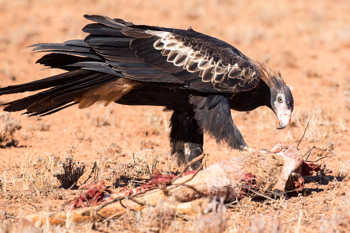The Wedge-tailed Eagle
 The wedge-tailed eagle is Australia’s largest living bird of prey and one of the largest eagles in the world.
The wedge-tailed eagle is Australia’s largest living bird of prey and one of the largest eagles in the world.
It measures 0.85-1.05m in length and has a wingspan of 2.3m. The female is larger than the male, reaching an average weight of 4.2kg and sometimes reaching 5.3kg! Males usually weigh between 3.2kg and 4.0kg.
Young wedge-tailed eagles are mid brown in colour with reddish-brown heads and wings. They become progressively blacker for at least the first ten years of their lives. An adult female is generally slightly paler than her mate. The bill is pale pink to cream, the iris brown to dark brown and the feet off-white.
The Wedge-tailed Eagle is found throughout mainland Australia. It prefers wooded and forested land and open country, but avoids rainforest and coastal regions. They can be seen soaring overhead at altitudes of up to 2,000m.
Wedge-tailed eagles build their nests in open locations with a good view of the surrounding countryside, usually in the tallest trees.
Why do they build their nests in tall open places?
If a breeding pair are disturbed when they are preparing to lay eggs they may abandon their nest.
The nest is a large structure of dead sticks, called an eyrie, which is usually reused for years and is often of a considerable size. The nest will usually hold two to three eggs.
When the chicks hatch they are covered in a light feathery down, and after two weeks they get their first feathers.
Each egg needs 42-45 days incubation and because of the intervals between laying, they do not hatch all together. The first chick hatches larger than the second, which in turn is larger than the third. Only one or two chicks will survive depending on local conditions.
What are the conditions needed for survival?
The chicks are then fed by both adults for five weeks or so. After five weeks they will recognise bits of food on the floor of the nest and feed themselves. Usually the largest chick will survive its brothers or sisters and if food is scarce it may eat its siblings!
If threatened, the chicks will lie flat in the nest and will defend themselves if necessary. They defend their nest vigorously and have been known to attack helicopters, hang-gliders, fixed-wing aircraft and model airplanes!
Juvenile eagles will remain with the adults for about 11 weeks after leaving the nest.
The wedge-tailed eagle’s diet reflects the availability of prey, but up to 92% its prey is rabbits and hares. They also eat lizards, birds, small mammals, and they will scavenge already dead birds and lambs. If food is scarce they will store their catch in a nearby treetop. Wedge-tailed eagles hunt alone, in pairs or in groups. Twenty birds may feed from a single carcass but only two or three will eat at any one time.
Wedge-tailed eagles mate for life. If one bird is killed the remaining one will find a new mate.
Read More: The Koala Bear